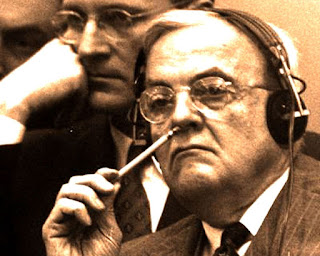So--how can something as moot and moribund as a dialect comedian be the catalyst for The Most Subversive Plan Yet™ to save baseball from its lingering case of sepsis? Well...first of all, pally, we're not talking about just any dialect comedian: we're talking about Harry Einstein (the father of Albert Brooks), who made a brilliant comeback at a Friars' Club Roast in 1958 only to die right on the spot.
That's right, the man who called himself
Parkyakarkus parked his carcass in the lap of
Milton Berle, and never opened his eyes again. File it under "brilliant but doomed," ticking time-bomb division. And baseball, with an encroaching sepsis (alarmingly high ISOBA) as sludgifying as any collection of clogged arteries, is in dire need of a transplant--but, characteristically, is unwilling to consider even a bypass operation.
So--what the hell, you say? Where is the oxygen in relation to your brain, Mr. Big Bad Baseball man? Put up or getyakarkus off the operating table, already.
OK, OK. We had a brilliant (but doomed) revelation yesterday (when all our troubles weren't nearly far enough away). It welled up from having glanced at 2021 baseball stats sorted by ballpark. As that other song goes, just one look was all it took, and we knew how to save the game from parking its own carcass at the feet of its (former) fans.
The ballpark data confirmed what we see in so many aspects of America's current malignity. We see fracture so advanced that there is little if any chance that the current crumbling edifice can be kept intact. We see backlash and denial; we see people who believe that they are entitled to cheat. And we have those who respond to all that with hand-wringing and a pandemic of glib catchphrases that do not exceed 280 characters in length.
 |
Come to think of it, America has been "lurching"
for the past sixty years... |
American society is lurching between death rattles, but baseball actually has a high-concept bypass operation staring it in the face that will give its fan base clear choices for the type of game they want to see. Unlike America, where too much of the data is fudged, baseball can't help but bring us the truth.
And while the powers that be will never implement any of what follows due to their kryptonitic desire to follow their not-so-inner death wish, we can lay out the surreal, brilliant-but-doomed (mooted?) path to baseball bliss that will, as promised in the title of this blog post, lead the game into a state of being best described as "three sheets to the wind."
The key is in the ballpark stats. They show us that there are three separate platforms in operation within the game today, exacerbated by all of the machinations in wake of
Moneyball and the deadly rise of ISOBA ("high isolated power = hypertension" fed into "declining batting average = ongoing onset of congestive heart failure"). While "launch angle" and "three true outcomes" and "Fangrafia sociopathis" have produced rampant infection within all of these platforms, counter-movements in pitching (up to and including the "all-American stick-up" that will produce an untoward amount of clickbait as the '21 season lurches along) have established a beachhead in ten ballparks, with several others showing signs of bringing a low-scoring variant of "homer derby ball" into play.
You can see those ten parks in the top portion of the table at right, where runs per game (per team) strongly resemble what some folks remember from 1967-68. These parks have been sorted in descending order of HR/G, and that method shows us that it's possible to hit homers at the league average rate (the hitters thus far in Yankee Stadium) and score only as many runs as is the case in the stingiest homer park in MLB (down in Miami).
We'll exclude that middle section (in pale orange) for a moment to pimp for the Big Contrast that's tangled up in blue. Here is the game as some will remember it from 1996-2002: run scoring galore, including several parks where the homers are like a July 4th fireworks show every night. Note, though, that even this group brings us several anomalies: robust run scoring with relative modest homer totals (Fenway, Chase, Coors, and Kauffman, where the aggregate batting average is between .265-.275 and folks still hit doubles at the elevated clip common during baseball's fin de siecle).
Perhaps you can see where this is going: we have ten teams in what we've fancifully called the "pitchorama" category, and ten teams mimicking the offensive explosion, which we've tagged as "batorama." That leaves ten teams, who are variously and variably following what the Buddhists have been known to call "the Middle Way." (They are not really a perfect fit, though they are at least linear in terms of run scoring. The "Midway" league will initally possess a bit of both approaches as opposed to forging its own unique style: but that's what the baseball brain trust has thrust upon us, particularly in the years that coincided with the Orange Menace.)
So--here's your oxygen for a game that is running on fumes: we go one better than Solomon by splitting the baby into three parts. That's right: three leagues, three ways that split the game into at least semi-distinct visions of its once and future self. While we are not (yet) getting three distinct styles of play (the work of the post-Moneyball wonks, the Statcast shills, and their enablers has kept that trend firmly under wraps, particularly in the last five years), we just might find that if you divide the game into segments that trend toward a inherent "run scoring aptitude," those games will develop in different directions and develop some truly unique characteristics.
How does it work? In fact, Mr. BBB, just how the hell can this work? How in blazes does your post-season operate, anyway? Amidst a wide range of possibilities, we (as usual) favor something outlandish and baroque. But, in the interest in getting at least a plurality of our readership to take this idea seriously, we offer the following semi-straightforward approach:
1) Each ten-team league has two five-team divisions. 2) Division winners (a total of six) and the wild-card team with the best won-loss record from the three leagues are given a "bye" while the two wild card teams with lesser records play a sudden-death game to reach the playoffs. 3) Once team #8 is determined, the playoffs proceed through first-round (taking us down to four teams), championship series (taking us down to two), and, finally, the World Series.
All of that is disturbingly prosaic, we admit. But fear not, we have saved the baroque stuff for how the regular season operates...
1) Within each league, teams play their four division opponents fourteen times, for a total of 56 games. 2) They then play their five opponents from their league's other division eight times, for a total of 40 more games.
That's a total of 96 games, and we need to schedule 66 more games to set up the standard 162-game season. 3) We do so by having each team play six games (the equivalent of a home-and-home series) against eleven teams from the other two leagues--which creates a very robust (and at least semi-baroque) interleague schedule.
In fact, with so many interleague games, a secondary post-season race could actually be superimposed into the playoff design, where the team with the best interleague record who did not win a division or qualify for the wild card via a 162-game won-loss record would be awarded the ninth slot instead of a third "standard" wild-card team. (The only caveat we might want to impose is that such a team must at least have a winning record; if not, then the third wild-card team is chosen in the standard manner.)
So--there you have it. "Designer baseball" with leagues offering distinct styles and statistical emphases. To be successful, teams will have to adapt to other ballparks and (potentially, at least) other distinct styles of play, in a manner similar to but somewhat different from what is the case at present.
Of course, if your team is not playing the type of baseball that you find most gratifying, you may have to change your allegiance. But perhaps it will still be reasonably recognizable as baseball: after all, that's what those who push back at those who criticize today's "homer derby" game. And perhaps folks will pick up on the nuances that shift due to the level of run scoring that this approach would attempt to "bake into" the game.
But that's where the rub comes in--what if all this ballpark stuff is more random than what's being represented here? Will teams try to re-calibrate their talent to escape or transcend the run scoring "channels" they may only superficially (or temporarily) belong to? How stable are the run-scoring constructs that formed our three leagues?
Glad you asked. (Actually, we asked for you, but pat yourself on the back anyway--this has been a long slog.) We combined the in-process 2021 ballpark data with its 2020 counterpart to see how it shifted things around. (We weren't too worried about team movement from one league to the other--that's something that could happen as part of this construct...another "beyond baroque" additive: after all, why shouldn't teams move from league to league? You say it's never been done?? As any number of officious butlers in most if not all of Preston Sturges' comedies would say: pish-posh. So many things are simply for the birds, but too much tradition is an albatross.)
We were more concerned that the tripartite structure that cohered in the '21 ballpark data would get muddled. But as you can see from our revised league set-up using multi-year data, that didn't happen. The impact of baseball's feverish embrace of high ISOBA seems likely to keep this tripartite structure reasonably intact for some time to come (until they break the fever, at any rate).
In this version of the three-league setup, six teams (shown in bold) shifted around, but the overall separation of run-scoring between the leagues did not tighten up egregiously. This version of the "Midway League" might be a bit too close to the overall model of "Orange Menace-era" baseball for our (and possibly your) taste, but the linear structure holds--and with it, the hope continues to spring eternal that a more free-wheeling game can emerge from the parked carcass of what we've been handed by the so-called "best and brightest."
And, of course, the post-season will redeem almost anything, since it separates the Yankees and the Red Sox from the former AL East and gives them a chance to do something they've never done: meet in the World Series.
Do we like this better than our four-league concept that we pitched not so long ago? At this moment in time, yes. Baseball may have limited opportunities to expand over the next few years, and it takes thirty-two teams to make a four-league setup viable.
Something like this, that revamps the existing system in a creative (and quirky) way, that opens up some possibilities for evolving distinct styles of play--and that takes away the medieval feel of the two-league arrangement with a post-season free-for-all that makes any World Series combination possible--feels like a much-needed breath of fresh air.
(Of course, we still want that 190-foot rule...and wait till you see what else we've come up with. But let's not make poor Harry Einstein spin in his grave just yet...)









































